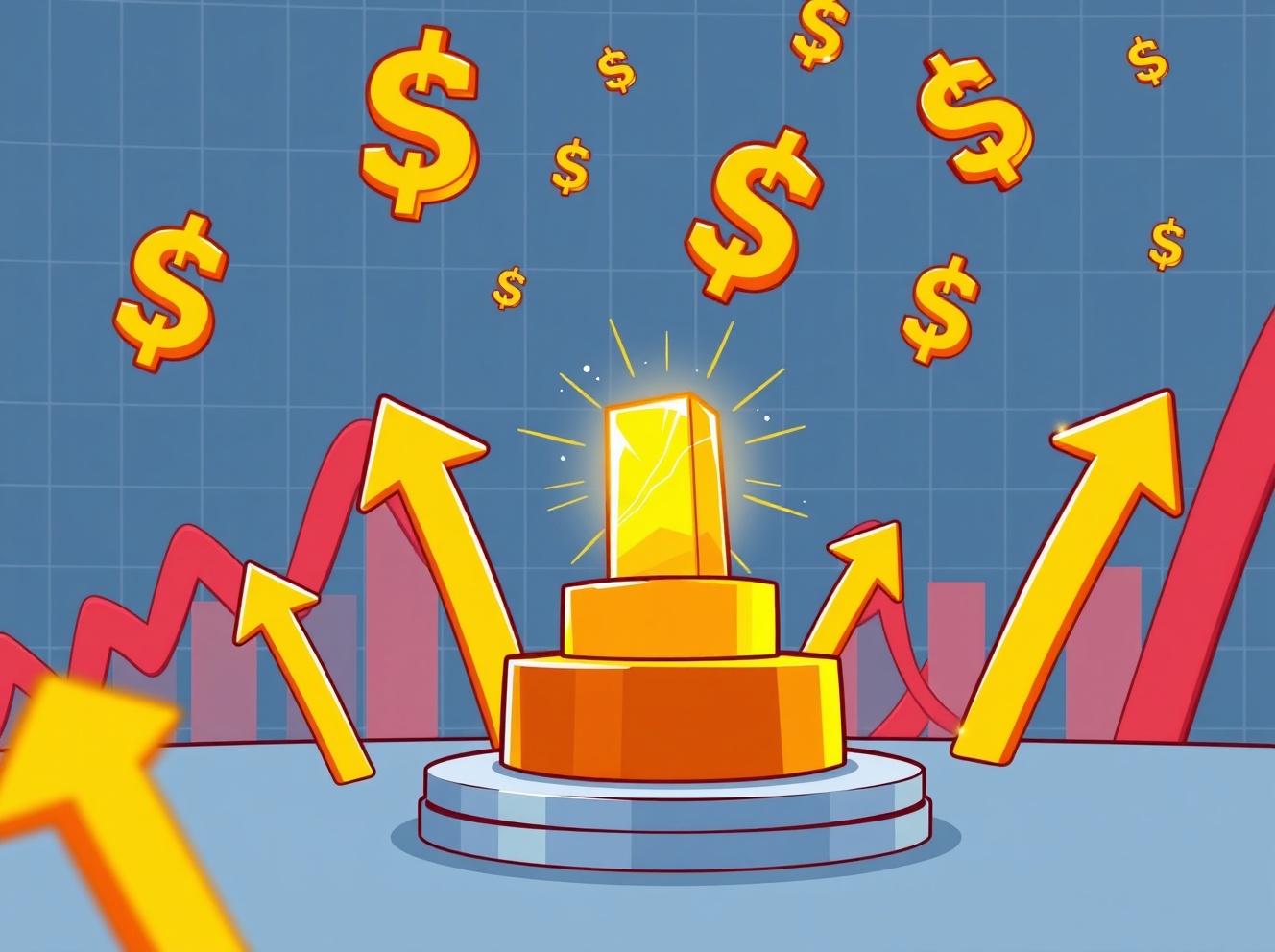Spot Gold Price Soars to $4,200: What This Stunning Rally Means for Investors

Share:
BitcoinWorld
Spot Gold Price Soars to $4,200: What This Stunning Rally Means for Investors
In a remarkable market movement, the spot gold price has surged to $4,200 per ounce, marking its highest level since late October. This stunning development has caught the attention of investors worldwide, signaling potential shifts in the global economic landscape. But what’s really driving this precious metal’s impressive performance?
Why Is the Spot Gold Price Climbing?
The recent surge in spot gold price reflects several key economic factors. Market uncertainty, inflation concerns, and geopolitical tensions typically drive investors toward safe-haven assets. Gold has historically served as a reliable store of value during turbulent times.
Moreover, central bank policies and currency fluctuations play crucial roles. When the dollar weakens, the spot gold price often strengthens, making it more attractive to international buyers. Current market conditions suggest this trend might continue in the coming weeks.
What Does This Mean for Your Investments?
Understanding the implications of rising gold prices is essential for smart portfolio management. Consider these key points:
- Diversification benefits – Gold often moves independently of stocks and bonds
- Inflation protection – Gold typically maintains purchasing power over time
- Risk management – Adding gold can reduce overall portfolio volatility
- Liquidity advantage – Gold markets remain active globally
The current spot gold price movement suggests investors are seeking stability. However, timing your entry requires careful consideration of market conditions.
How Can You Capitalize on Gold’s Momentum?
Several investment vehicles allow exposure to the spot gold price without physical storage concerns. Exchange-traded funds (ETFs) and gold mining stocks offer convenient alternatives. Each option carries different risk profiles and potential returns.
Remember that past performance doesn’t guarantee future results. The spot gold price can be volatile, so proper position sizing remains crucial. Consulting with financial professionals can help align gold investments with your overall strategy.
What’s Next for Gold Markets?
Market analysts watch several indicators to predict future spot gold price movements. Key factors include:
- Federal Reserve interest rate decisions
- Global economic growth projections
- Currency exchange rate fluctuations
- Geopolitical developments
- Central bank gold purchases
The current spot gold price level at $4,200 represents a significant psychological barrier. Breaking through this resistance could signal further upward momentum.
Conclusion: Navigating the Golden Opportunity
The spot gold price reaching $4,200 marks an important milestone for investors. This movement underscores gold’s enduring role as a wealth preservation tool. While short-term fluctuations are inevitable, gold’s long-term value proposition remains compelling.
Successful investors monitor the spot gold price within broader market context. They understand that gold serves as insurance rather than quick-profit speculation. The current environment suggests maintaining some gold exposure could provide valuable portfolio protection.
Frequently Asked Questions
What causes gold prices to rise?
Gold prices typically increase during economic uncertainty, high inflation periods, and geopolitical tensions. The spot gold price also responds to currency movements, particularly dollar strength.
Is now a good time to buy gold?
While the spot gold price has reached recent highs, many investors consider gold a long-term holding. Dollar-cost averaging can help manage timing risks.
How does gold perform during recessions?
Gold often performs well during economic downturns as investors seek safe assets. The spot gold price frequently increases when other investments decline.
What’s the difference between spot gold and gold futures?
Spot gold refers to immediate delivery at current prices, while futures contracts specify future delivery dates. The spot gold price serves as the benchmark for physical transactions.
Can I invest in gold through my retirement account?
Yes, many retirement accounts allow gold ETF investments. Some specialized accounts even permit physical gold ownership, though storage requirements apply.
How much of my portfolio should be in gold?
Financial advisors typically recommend 5-10% allocation to gold, depending on individual risk tolerance and investment objectives.
Found this analysis of the spot gold price movement helpful? Share this article with fellow investors on social media to spread valuable market insights!
To learn more about the latest precious metals trends, explore our article on key developments shaping gold price action and institutional adoption.
This post Spot Gold Price Soars to $4,200: What This Stunning Rally Means for Investors first appeared on BitcoinWorld.
Spot Gold Price Soars to $4,200: What This Stunning Rally Means for Investors

Share:
BitcoinWorld
Spot Gold Price Soars to $4,200: What This Stunning Rally Means for Investors
In a remarkable market movement, the spot gold price has surged to $4,200 per ounce, marking its highest level since late October. This stunning development has caught the attention of investors worldwide, signaling potential shifts in the global economic landscape. But what’s really driving this precious metal’s impressive performance?
Why Is the Spot Gold Price Climbing?
The recent surge in spot gold price reflects several key economic factors. Market uncertainty, inflation concerns, and geopolitical tensions typically drive investors toward safe-haven assets. Gold has historically served as a reliable store of value during turbulent times.
Moreover, central bank policies and currency fluctuations play crucial roles. When the dollar weakens, the spot gold price often strengthens, making it more attractive to international buyers. Current market conditions suggest this trend might continue in the coming weeks.
What Does This Mean for Your Investments?
Understanding the implications of rising gold prices is essential for smart portfolio management. Consider these key points:
- Diversification benefits – Gold often moves independently of stocks and bonds
- Inflation protection – Gold typically maintains purchasing power over time
- Risk management – Adding gold can reduce overall portfolio volatility
- Liquidity advantage – Gold markets remain active globally
The current spot gold price movement suggests investors are seeking stability. However, timing your entry requires careful consideration of market conditions.
How Can You Capitalize on Gold’s Momentum?
Several investment vehicles allow exposure to the spot gold price without physical storage concerns. Exchange-traded funds (ETFs) and gold mining stocks offer convenient alternatives. Each option carries different risk profiles and potential returns.
Remember that past performance doesn’t guarantee future results. The spot gold price can be volatile, so proper position sizing remains crucial. Consulting with financial professionals can help align gold investments with your overall strategy.
What’s Next for Gold Markets?
Market analysts watch several indicators to predict future spot gold price movements. Key factors include:
- Federal Reserve interest rate decisions
- Global economic growth projections
- Currency exchange rate fluctuations
- Geopolitical developments
- Central bank gold purchases
The current spot gold price level at $4,200 represents a significant psychological barrier. Breaking through this resistance could signal further upward momentum.
Conclusion: Navigating the Golden Opportunity
The spot gold price reaching $4,200 marks an important milestone for investors. This movement underscores gold’s enduring role as a wealth preservation tool. While short-term fluctuations are inevitable, gold’s long-term value proposition remains compelling.
Successful investors monitor the spot gold price within broader market context. They understand that gold serves as insurance rather than quick-profit speculation. The current environment suggests maintaining some gold exposure could provide valuable portfolio protection.
Frequently Asked Questions
What causes gold prices to rise?
Gold prices typically increase during economic uncertainty, high inflation periods, and geopolitical tensions. The spot gold price also responds to currency movements, particularly dollar strength.
Is now a good time to buy gold?
While the spot gold price has reached recent highs, many investors consider gold a long-term holding. Dollar-cost averaging can help manage timing risks.
How does gold perform during recessions?
Gold often performs well during economic downturns as investors seek safe assets. The spot gold price frequently increases when other investments decline.
What’s the difference between spot gold and gold futures?
Spot gold refers to immediate delivery at current prices, while futures contracts specify future delivery dates. The spot gold price serves as the benchmark for physical transactions.
Can I invest in gold through my retirement account?
Yes, many retirement accounts allow gold ETF investments. Some specialized accounts even permit physical gold ownership, though storage requirements apply.
How much of my portfolio should be in gold?
Financial advisors typically recommend 5-10% allocation to gold, depending on individual risk tolerance and investment objectives.
Found this analysis of the spot gold price movement helpful? Share this article with fellow investors on social media to spread valuable market insights!
To learn more about the latest precious metals trends, explore our article on key developments shaping gold price action and institutional adoption.
This post Spot Gold Price Soars to $4,200: What This Stunning Rally Means for Investors first appeared on BitcoinWorld.






